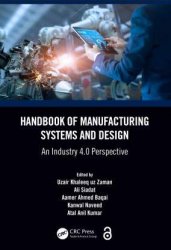Handbook of Manufacturing Systems and Design: An Industry 4.0 Perspective
- Добавил: literator
- Дата: 6-08-2023, 02:16
- Комментариев: 0
 Название: Handbook of Manufacturing Systems and Design: An Industry 4.0 Perspective
Название: Handbook of Manufacturing Systems and Design: An Industry 4.0 PerspectiveАвтор: Uzair Khaleeq uz Zaman, Ali Siadat,Aamer Ahmed Baqai
Издательство: CRC Press
Год: 2024
Страниц: 345
Язык: английский
Формат: pdf (true)
Размер: 33,3 MB
This book provides a comprehensive overview of manufacturing systems, their role in product/process design, and their interconnection with an Industry 4.0 perspective, especially related to design, manufacturing, and operations.
Handbook of Manufacturing Systems and Design: An Industry 4.0 Perspective provides the knowledge related to the theories and concepts of Industry 4.0. It focuses on the different types of manufacturing systems in Industry 4.0 along with associated design, and control strategies. It concentrates on the operations in Industry 4.0 with a particular focus on supply chain, logistics, risk management, and reverse engineering perspectives. Offering basic concepts and applications through to advanced topics, the handbook feeds into the goal of being a source of knowledge as well as a vehicle to explore the future possibilities of design, techniques, methods, and operations associated with Industry 4.0. Concepts with practical applications in the form of case studies are added to each chapter to round out the many attributes this handbook offers.
Manufacturing systems have undergone a massive transformation in the past decade, and the concept of Industry 4.0 has significantly shaped this evolution. Industry 4.0 refers to integrating advanced technologies such as Internet of Things (IoT), Artificial Intelligence (AI), and cyber-physical systems into manufacturing processes to create smart factories capable of autonomous decision-making and optimization.
For this handbook, we have secured contributions from leading researchers and practitioners from around the globe who have identified critical elements that could be made part of this handbook. It consists of 17 chapters and follows a process-systems engineering approach to design, monitoring, and control of smart manufacturing systems and covers all aspects from design to supply chain and logistics. The topics covered include computer-aided process planning, Quality 4.0, digital twins, robotic systems, control strategies, sensors, energy harvesters, IoT, Logistics 4.0, cloud manufacturing, risk management, and reverse engineering, among others.
The engineering process consists of designing, assembling, and manufacturing the products and their maintenance. Moreover, engineering is classified into Forward Engineering (FE) and Reverse Engineering (RE). FE is a conventional technique for transforming the conceptual design into a logical design and finally implementing it physically. In some positions, the designed part/product needs more technical details such as engineering drawings, bill-of-materials, and manufacturing processes. For such situations, processes are replicated to achieve existing parts, subassemblies, and products without the available engineering drawings, data sets, and computational models, thereby inviting the concept of RE. Yau et al. defined RE as a process of retrieving new geometry using a manufactured product and modifying the previous computer-aided design (CAD) model through digitization. Numerous researchers described RE as capturing a component’s physical entities through digital analysis. It is a process of obtaining a CAD model through 3D points captured using scanning and digitizing the existing products. RE can also be termed a learning process and implementing how an object works. It includes and is not limited to software, physical machines, and military technologies. Even biological functions related to how genes work can be reverse-engineered. Furthermore, RE software requires many essential tools to reverse engineer a product properly. RE is primarily used to replicate a product more inexpensively or because the original product is no longer available.
This handbook targets students, engineers, managers, designers, and manufacturers, and will assist in their understanding of the core concepts of manufacturing systems in connection with Industry 4.0 and optimize alignment between supply and demand in real time for effective implementation of the design concepts.
Contents:
Скачать Handbook of Manufacturing Systems and Design: An Industry 4.0 Perspective
Внимание
Уважаемый посетитель, Вы зашли на сайт как незарегистрированный пользователь.
Мы рекомендуем Вам зарегистрироваться либо войти на сайт под своим именем.
Уважаемый посетитель, Вы зашли на сайт как незарегистрированный пользователь.
Мы рекомендуем Вам зарегистрироваться либо войти на сайт под своим именем.
Информация
Посетители, находящиеся в группе Гости, не могут оставлять комментарии к данной публикации.
Посетители, находящиеся в группе Гости, не могут оставлять комментарии к данной публикации.

